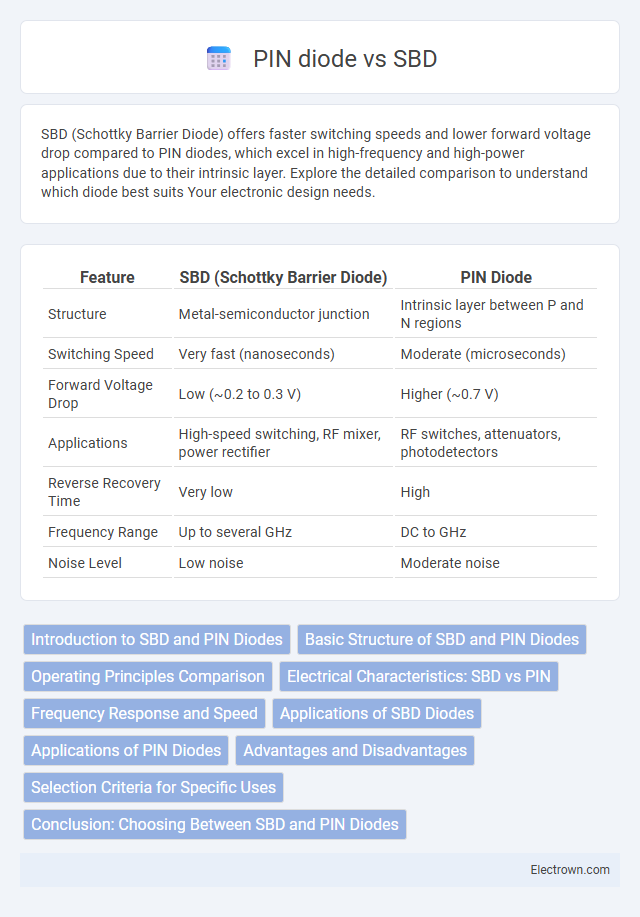SBD (Schottky Barrier Diode) offers faster switching speeds and lower forward voltage drop compared to PIN diodes, which excel in high-frequency and high-power applications due to their intrinsic layer. Explore the detailed comparison to understand which diode best suits Your electronic design needs.
Table of Comparison
| Feature | SBD (Schottky Barrier Diode) | PIN Diode |
|---|---|---|
| Structure | Metal-semiconductor junction | Intrinsic layer between P and N regions |
| Switching Speed | Very fast (nanoseconds) | Moderate (microseconds) |
| Forward Voltage Drop | Low (~0.2 to 0.3 V) | Higher (~0.7 V) |
| Applications | High-speed switching, RF mixer, power rectifier | RF switches, attenuators, photodetectors |
| Reverse Recovery Time | Very low | High |
| Frequency Range | Up to several GHz | DC to GHz |
| Noise Level | Low noise | Moderate noise |
Introduction to SBD and PIN Diodes
Schottky Barrier Diodes (SBD) feature a metal-semiconductor junction that provides low forward voltage drop and fast switching, making them ideal for high-frequency and power-sensitive applications. PIN diodes contain an intrinsic semiconductor region between the p-type and n-type layers, offering high linearity and variable resistance, which is essential for RF switches and attenuators. Understanding the distinct constructions and electrical behaviors of your SBD and PIN diodes enables optimized selection for specific electronic circuit needs.
Basic Structure of SBD and PIN Diodes
Schottky Barrier Diodes (SBD) feature a metal-semiconductor junction, typically formed by a metal layer directly contacting an n-type semiconductor, creating a low forward voltage drop and fast switching capabilities. PIN diodes consist of an intrinsic (undoped) semiconductor layer sandwiched between p-type and n-type regions, which enables excellent control of the diode's resistance under varying bias and high-frequency performance. Understanding the basic structure of these diodes helps optimize your circuit design for applications requiring fast switching or RF modulation.
Operating Principles Comparison
Schottky Barrier Diodes (SBD) operate based on a metal-semiconductor junction that facilitates majority carrier conduction, resulting in low forward voltage drop and fast switching speeds. PIN diodes utilize an intrinsic layer between p-type and n-type regions, enabling controlled conductivity modulation and high-frequency signal attenuation, especially in RF applications. The fundamental difference lies in SBD's unipolar conduction versus PIN diode's variable resistance controlled by carrier lifetime in the intrinsic region.
Electrical Characteristics: SBD vs PIN
SBD diodes exhibit low forward voltage drop and fast switching speed, making them ideal for high-frequency applications, while PIN diodes feature higher forward voltage and greater charge storage, enabling efficient RF attenuation and switching. The intrinsic layer in PIN diodes introduces higher junction capacitance and longer recovery times compared to SBDs, which have minimal charge storage and lower junction capacitance, resulting in superior performance in low-noise applications. Your choice depends on whether fast switching and low voltage loss (SBD) or high power handling and RF modulation (PIN diode) are essential for your device.
Frequency Response and Speed
Schottky Barrier Diodes (SBD) exhibit superior frequency response and switching speeds compared to PIN diodes due to their majority carrier conduction mechanism, enabling operation in the microwave and millimeter-wave frequency bands. PIN diodes rely on minority carrier injection in the intrinsic region, resulting in slower switching times and reduced high-frequency performance. Consequently, SBDs are preferred in high-speed applications such as mixers and detectors, whereas PIN diodes are favored for RF attenuators and variable capacitors requiring slower response.
Applications of SBD Diodes
Schottky Barrier Diodes (SBD) are widely used in RF and microwave applications due to their low forward voltage drop and fast switching speed, making them ideal for mixer circuits, detectors, and power rectifiers in high-frequency communication systems. Their ability to operate at high frequencies with minimal signal distortion makes them preferred components in radio frequency (RF) front-end modules and voltage clippers in radar and satellite systems. SBD diodes also enhance power efficiency in solar cell bypass diodes and protect circuits from voltage spikes in power management applications.
Applications of PIN Diodes
PIN diodes are widely used in RF and microwave circuits as switches, attenuators, and photodetectors due to their ability to handle high frequencies and power levels. Unlike Schottky Barrier Diodes (SBD), PIN diodes exhibit a wide intrinsic region that provides higher resistance in the off state and lower resistance in the on state, enabling efficient control of signal flow. These properties make PIN diodes essential in radar systems, communication devices, and signal modulation applications.
Advantages and Disadvantages
SBD (Schottky Barrier Diode) offers low forward voltage drop and fast switching speed, making it ideal for high-frequency applications, but it has lower reverse voltage capability and higher leakage current compared to PIN diodes. PIN diodes provide excellent RF switching and attenuation with high reverse voltage tolerance and low distortion, yet exhibit higher forward voltage drop and slower switching speed that may limit efficiency. Your choice between SBD and PIN diodes depends on the requirements for speed, voltage handling, and power efficiency in your specific application.
Selection Criteria for Specific Uses
SBD (Schottky Barrier Diode) is selected for high-speed switching and low forward voltage drop, making it ideal for power rectification and RF applications. PIN diodes are preferred in RF and microwave circuits where variable resistance, high-frequency switching, and signal modulation are required due to their intrinsic layer and high reverse breakdown voltage. The choice depends on the application's frequency, power handling, switching speed, and voltage requirements, with SBDs favored for efficiency and PIN diodes for RF control.
Conclusion: Choosing Between SBD and PIN Diodes
SBD diodes excel in high-speed switching and low forward voltage drop, making them ideal for RF applications and fast rectification. PIN diodes offer superior performance in high-frequency RF attenuation and power control due to their intrinsic layer, providing better linearity and power handling. Your choice depends on whether switching speed or RF control is the priority in your circuit design.
SBD vs PIN diode Infographic

 electrown.com
electrown.com